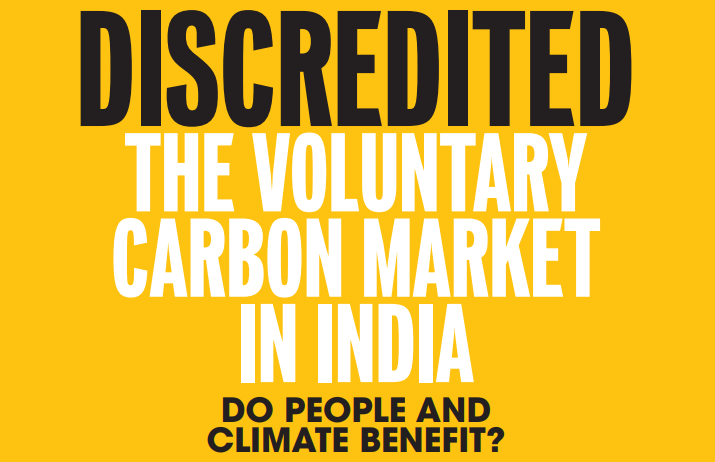Saviours Or Sham? Voluntary Carbon Markets In Spotlight In CSE Report

The global voluntary carbon market (VCM) sector has exploded in recent years, and India has been an integral part of this boom. The country has become the world’s second-largest source of carbon offsets in the voluntary carbon market. As of June 2023, over 1,400 projects are registered or are under various stages of consideration in the two major crediting programmes — Verra and Gold Standard. Indian projects account for one-fifth of the total carbon credits issued under these two programmes.
But this boom brings with it a strong whiff of fraud, finds a new investigative report by Centre for Science and Environment (CSE) and Down To Earth. ‘Discredited: Does the Voluntary Carbon Market Benefit People and Climate in India?’ begins by asking some fundamental questions: does VCM help in the reduction of global GHG emissions? Does it guarantee financial benefits to carbon-sequestering communities and sectors which would otherwise not get financing?
With its focus on the supply side of VCM – projects on the ground that are doing the heavy lifting of carbon avoidance or sequestration, while companies abroad buy credits and claim their net zero targets – the CSE-DTE investigation has zeroed in on hundreds of projects in Verra and Gold Standard’s registries and communicated with their developers. The investigation team also visited close to 40 locations in four Indian states for an on-ground assessment, speaking to project developers, farmers, rural households, activists, and local NGOs.
The team’s expose is an eye-opener: it shows how there are no rules in this market which is under a shroud of secrecy and opaque at best. They go as far as suggesting that some of these could actually increase carbon emissions! And its not just about India too. It highlights how a report by The Guardian, based on an investigation conducted in association with Die Ziet (German Weekly) and SourceMaterial, on Verra’s rainforest-based credit programme raised a storm in voluntary carbon markets in early 2023.
The investigation revealed that over 90 per cent of rainforest offset credits certified by Verra and retired by corporations like Disney, Shell and Gucci were not representing emission reductions and were essentially hot air. The investigation was based on three studies conducted on REDD+ projects. Two of these studies investigated 58 of the 87 Verra approved REDD+ projects. 21 projects were found to have no climate benefit and others were similarly noted to be less efficient
“One of the fundamental flaws of voluntary carbon markets is that there is no basis of the price put on a project; at times it is inflated and at times it is so low that the project becomes unviable. It seems that the entire purpose of voluntary carbon markets is to serve the interests of project developers, auditors and all the others who make a cut in this carbon business.
The current carbon markets could end up increasing emissions in the world. The buyers of credit—say an airline company that has
assured its customers to offset their carbon footprint or a food company that has declared itself net-zero—continue to emit; they
even increase their emissions, saying that they have bought credits. But as these credits have been over-estimated or do not really exist, the reductions are notional. This is a double-jeopardy. This is exactly what a climate-risked world does not need”
All of this, even as the leading firm in the India market EKI Energy Services, goes through a serious issue of corporate governance in the past year does not help inspire confidence at all.
The report proposes multiple steps that need to be taken to clear up the odour around VCMs.
- Ensure transparency
The first, and the obvious step, is to ensure transparency in the markets. The details of the projects should be listed. There should be information about the price that each credit has earned. - Pay for real change
The second step is to decide once and for all the objective of the markets—voluntary, bilateral or multilateral—and design rules
accordingly. If the purpose of the markets is to invest in projects that will lead to reduction in emissions in different parts of the
world, then the markets must be based on paying for the real cost of the projects. Consider renewable energy projects, which are
critical for making the transition to clean energy in countries of the South. The current voluntary carbon market pays a fraction of the capital cost of these projects in India. At less than 10% of the costs for renewable energy as well as Biogas projects, carbn markets are doing next to nothing to support faster adoption. - Share the proceeds
The third step to ponder on is who these markets are meant for. Currently, the markets only seems to work in the interest of the
project developers and, of course, the paraphernalia of consultants and auditors. This also means that they are ineffective in terms of real emission reduction. The communities get virtually nothing from the proceeds and this means that they also have no stake in the emission reduction programme. - Keep it simple
The fourth is to accept that the voluntary carbon market also shows how the all the King’s smart men have fallen. Despite spending on verification, auditing and registration, these agencies seem to have got so much wrong. They cannot even calculate the emission reduction of one cookstove—Greenways says its stove reduces 2–4 tonnes of CO2e each year; EKI says the reduction is 5.7 tonnes. We know that this has to do with thermal dynamics of a small household device but there is no way it can be so different, especially as the fuel used is still wood. - Countries must account
The fifth and the most crucial lesson is that the ownership of trees grown on the land of the tribals in Araku valley has been transferred to a foreign entity. Let’s for a moment forget that these lands are under Schedule V of the Indian Constitution, which prohibits any outsider from diverting the claim of tribals. The fact is that these trees are grown by people on their lands. Under which agreement can any agencies have the right to decide how the tree will now be used—harvested or not. It is the same question when it comes to countries. Even more so.




